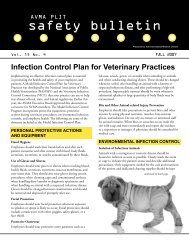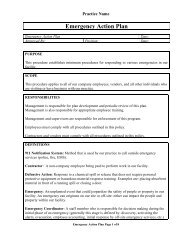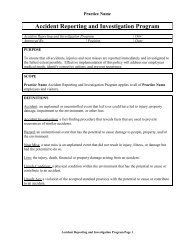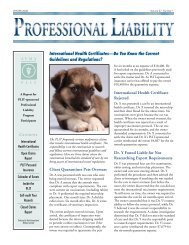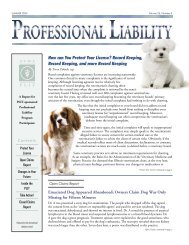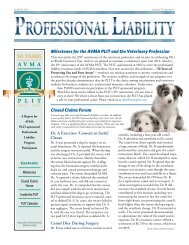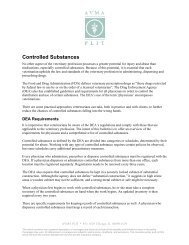§1904.29have also been designed to fit on the same-sizepaper as the <strong>OSHA</strong> 300 Log. For those employerswho use computerized systems (where handwritingspace is not as important) equivalent computer-generatedforms can be printed out on 81/2 x 11 sheets ofpaper if the printed copies are legible and are asreadable as the <strong>OSHA</strong> forms....Defining Lost Workdays<strong>OSHA</strong> proposed to eliminate the term “lost workdays,”by replacing it with “days away from work”(61 FR 4033). The <strong>OSHA</strong> recordkeeping system hashistorically defined lost workdays as including bothdays away from work and days of restricted workactivity, and the <strong>Recordkeeping</strong> Guidelines discussedhow to properly record lost workday cases with daysaway from work and lost workday cases with days ofrestricted work activity (Ex. 2, p. 47, 48). However,many use the term “lost workday” in a manner thatis synonymous with “day away from work,” and theterm has been used inconsistently for many years....In the final rule, <strong>OSHA</strong> has eliminated the term“lost workdays” on the forms and in the regulatorytext. The use of the term has been confusing formany years because many people equated the terms“lost workday” with “days away from work” andfailed to recognize that the former <strong>OSHA</strong> term includedrestricted days. <strong>OSHA</strong> finds that deleting this termfrom the final rule and the forms will improve clarityand the consistency of the data.The 300 Log has four check boxes to be used toclassify the case: death, day(s) away from work,day(s) of restricted work or job transfer; and casemeeting other recording criteria. The employer mustcheck the single box that reflects the most severeoutcome associated with a given injury or illness.Thus, for an injury or illness where the injured workerfirst stayed home to recuperate and then wasassigned to restricted work for several days, theemployer is required only to check the box for daysaway from work (column I). For a case with only jobtransfer or restriction, the employer must check thebox for days of restricted work or job transfer(Column H). However, the final Log still allowsemployers to calculate the incidence rate formerlyreferred to as a “lost workday injury and illness rate”despite the fact that it separates the data formerlycaptured under this heading into two separate categories.Because the <strong>OSHA</strong> Form 300 has separatecheck boxes for days away from work cases andcases where the employee remained at work but wastemporarily transferred to another job or assigned torestricted duty, it is easy to add the totals from thesetwo columns together to obtain a single total to usein calculating an injury and illness incidence rate fortotal days away from work and restricted work cases.Counting Days of Restricted Work or Job TransferAlthough the final rule does not use the term “lostworkday” (which formerly applied both to days awayfrom work and days of restricted or transferredwork), the rule continues <strong>OSHA</strong>’s longstanding practiceof requiring employers to keep track of the numberof days on which an employee is placed onrestricted work or is on job transfer because of aninjury or illness....In the final rule, <strong>OSHA</strong> has decided to requireemployers to record the number of days of restrictionor transfer on the <strong>OSHA</strong> 300 Log. From the commentsreceived, and based on <strong>OSHA</strong>’s own experience,the Agency finds that counts of restricted daysare a useful and needed measure of injury and illnessseverity. <strong>OSHA</strong>’s decision to require the recordingof restricted and transferred work cases on theLog was also influenced by the trend toward restrictedwork and away from days away from work....The final rule thus carries forward <strong>OSHA</strong>’s longstandingrequirement for employers to count andrecord the number of restricted days on the <strong>OSHA</strong>Log. On the Log, restricted work counts are separatedfrom days away from work counts, and the term“lost workday” is no longer used. <strong>OSHA</strong> believesthat the burden on employers of counting these dayswill be reduced somewhat by the simplified definitionof restricted work, the counting of calendar daysrather than work days, capping of the counts at 180days, and allowing the employer to stop countingrestricted days when the employees job has beenpermanently modified to eliminate the routine jobfunctions being restricted (see the PreambleDiscussion for 1904.7 General Recording Criteria).Separate 300 Log Data on Occupational Injury andOccupational Illness...After a thorough review of the comments in therecord...<strong>OSHA</strong> has concluded that the proposedapproach, which would have eliminated, for recordingpurposes, the distinction between work-relatedinjuries and illnesses, is not workable in the final rule.The Agency finds that there is a continuing need forseparately identifiable information on occupationalillnesses and injuries, as well as on certain specificcategories of occupational illnesses. The publishedBLS statistics have included separate estimates of therate and number of occupational injuries and illnessesfor many years, as well as the rate and number of112<strong>OSHA</strong> RECORDKEEPINGHANDBOOK
different types of occupational illnesses, and employers,employees, the government, and the public havefound this information useful and worthwhile.Separate illness and injury data are particularly usefulat the establishment level, where employers andemployees can use them to evaluate the establishment’shealth experience and compare it to thenational experience or to the experience of otheremployers in their industry or their own prior experience.The data are also useful to <strong>OSHA</strong> personnelperforming worksite inspections, who can use thisinformation to identify potential health hazards at theestablishment.Under the final rule, the <strong>OSHA</strong> 300 form hastherefore been modified specifically to collect informationon [four] types of occupational health conditions:...skindiseases or disorders, respiratory conditions,poisoning, and hearing loss. There is also an“all other illness” column on the Log. To recordcases falling into one of these categories, theemployer simply enters a check mark in the appropriatecolumn, which will allow these cases to be separatelycounted to generate establishment-level summaryinformation at the end of the year....In the final rule, two of the illness case columns onthe <strong>OSHA</strong> 300 Log are identical to those on the former<strong>OSHA</strong> Log: a column to capture cases of skin diseasesor disorders and one to capture cases of systemicpoisoning. The single column for respiratoryconditions on the new <strong>OSHA</strong> Form 300 will capturedata on respiratory conditions that were formerly capturedin two separate columns, i.e., the columns forrespiratory conditions due to toxic agents (formerlycolumn 7c) and for dust diseases of the lungs (formerlycolumn 7b). Column 7g of the former <strong>OSHA</strong>Log provided space for data on all other occupationalillnesses, and that column has also been continuedon the new <strong>OSHA</strong> 300 Log. On the other hand, column7e from the former <strong>OSHA</strong> Log, which capturedcases of disorders due to physical agents, is notincluded on the new <strong>OSHA</strong> Log form. The casesrecorded in former column 7e primarily addressedheat and cold disorders, such as heat stroke andhypothermia; hyperbaric effects, such as caisson disease;and the effects of radiation, including occupationalillnesses caused by x-ray exposure, sun exposureand welder’s flash. Because space on the form isat a premium, and because column 7e was not usedextensively in the past (recorded column 7e casesaccounted only for approximately five percent of alloccupational illness cases), <strong>OSHA</strong> has not continuedthis column on the new <strong>OSHA</strong> 300 Log.<strong>OSHA</strong> has, however, added a new column specificallyto capture hearing loss cases on the <strong>OSHA</strong> 300Log. The former Log included a column devoted torepeated trauma cases, which were defined asincluding noise-induced hearing loss cases as well ascases involving a variety of other conditions, includingcertain musculoskeletal disorders. Dedicating acolumn to occupational hearing loss cases will providea valuable new source of information on thisprevalent and often disabling condition. Althoughprecise estimates of the number of noise-exposedworkers vary widely by industry and the definition ofnoise dose used, the EPA estimated in 1981 thatabout 9 million workers in the manufacturing sectoralone were occupationally exposed to noise levelsabove 85 dBA. Recent risk estimates suggest thatexposure to this level of noise over a working lifetimewould cause material hearing impairment inabout 9 percent, or approximately 720,000, U.S.workers (NIOSH, 1998). A separate column for occupationalhearing loss is also appropriate because theBLS occupational injury and illness statistics onlyreport detailed injury characteristics information forthose illness cases that result in days away fromwork. Because most hearing loss cases do not resultin time off the job, the extent of occupational hearingloss has not previously been accurately reflected inthe national statistics. By creating a separate columnfor occupational hearing loss cases, and clearly articulatingin section 1904.10 of the final rule the level ofhearing loss that must be recorded, <strong>OSHA</strong> believesthat the recordkeeping system will, in the future, provideaccurate estimates of the incidence of workrelatedloss of hearing among America’s workers....[In the June 30, 2003 Federal Register (Vol. 68, No.125, page 38606), <strong>OSHA</strong> concluded that the MSDScolumn on the log was unnecessary, and Section1904.12 was deleted.][In the December 17, 2002, Federal Register (Vol. 67,No. 242, page 77169), <strong>OSHA</strong> delayed Section1904.10(b)(7) requirements for the hearing loss columnuntil January 1, 2004.]Miscellaneous 300 Form Issues...<strong>OSHA</strong> has not added the fields or columns suggestedby commenters to the final 300 or 301 formsbecause the available space on the form has beenallocated to other data that <strong>OSHA</strong> considers morevaluable. In addition, there is no requirement in thefinal rule for employers to enter any part of anemployee’s social security number because of thespecial privacy concerns that would be associated§1904.29<strong>OSHA</strong> RECORDKEEPINGHANDBOOK113
- Page 1 and 2:
www.osha.govOSHARecordkeepingHandbo
- Page 3 and 4:
OSHARecordkeeping HandbookThe Regul
- Page 5 and 6:
ContentsRecordkeeping HandbookRoadm
- Page 7 and 8:
Section 1904.40Providing records to
- Page 10 and 11:
§1904.0…OSHA has rejected the su
- Page 12 and 13:
§1904.1Since publication of the re
- Page 14 and 15:
§1904.2SIC code Industry descripti
- Page 16 and 17:
§1904.2tinue to have injury and il
- Page 18 and 19:
Section 1904.3Keeping records for m
- Page 20 and 21:
PREAMBLE DISCUSSION: Section 1904.4
- Page 22 and 23:
(viii)(ix)The illness is the common
- Page 24 and 25:
§1904.5employment environment. For
- Page 26 and 27:
§1904.5the employee’s status as
- Page 28 and 29:
§1904.5Exceptions Proposed but Not
- Page 30 and 31:
§1904.5pain and swelling in a join
- Page 32 and 33:
§1904.5the worker has taken a side
- Page 34 and 35:
§1904.526“Personal tasks” for
- Page 36 and 37:
If the accident had occurred in a l
- Page 38 and 39:
Scenario 4:• An employee reports
- Page 40 and 41:
In applying [the presumption of wor
- Page 42 and 43:
Letters of interpretation related t
- Page 44 and 45:
November 19, 2002Joseph Woodward, E
- Page 46 and 47:
Letter of interpretation related to
- Page 48 and 49:
§1904.6that the two injuries or il
- Page 50 and 51:
§1904.6…Under the OSHA recordkee
- Page 52 and 53:
FREQUENTLY ASKED QUESTIONS: Section
- Page 54 and 55:
Since the employee was not performi
- Page 56 and 57:
In each of the eight scenarios in y
- Page 58 and 59:
§1904.7other licensed health care
- Page 60 and 61:
§1904.7that eliminates the routine
- Page 62 and 63:
§1904.7pose. This paragraph also s
- Page 64 and 65:
§1904.7Counting Lost Workdays When
- Page 66 and 67:
§1904.7tors to such injuries and i
- Page 68 and 69:
§1904.7This list of first aid trea
- Page 70 and 71: §1904.7visit to a health care prof
- Page 72 and 73: §1904.7However, as discussed above
- Page 74 and 75: §1904.766immediate recording of si
- Page 76 and 77: §1904.7strength? How is an employe
- Page 78 and 79: §1904.7or illness. The severity of
- Page 80 and 81: The first treatment is glue used to
- Page 82 and 83: Response: The employer would have t
- Page 84 and 85: Letter of interpretation related to
- Page 86 and 87: Letter of interpretation related to
- Page 88 and 89: §1904.8exposure” as these terms
- Page 90 and 91: ing blood and other potentially inf
- Page 92 and 93: standard. In some cases employers v
- Page 94 and 95: PART 1904—[AMENDED] (67 FR 77170,
- Page 96 and 97: §1904.1088OSHA RECORDKEEPINGcorrec
- Page 98 and 99: §1904.1090OSHA RECORDKEEPINGAwaren
- Page 100 and 101: §1904.1092reasonable checks agains
- Page 102 and 103: §1904.1094determination. Second, t
- Page 104 and 105: FREQUENTLY ASKED QUESTIONS: Section
- Page 106 and 107: Also, from time to time we update o
- Page 108 and 109: §1904.11Section 1904.11Recording c
- Page 110 and 111: §1904.11of causation applies to th
- Page 112 and 113: §1904.12Thus, the total MSD count
- Page 114 and 115: §1904.12current survey was designe
- Page 116 and 117: §1904.29son’s blood or other pot
- Page 118 and 119: §1904.29cern cases, and the list m
- Page 122 and 123: §1904.29with that entry and employ
- Page 124 and 125: FREQUENTLY ASKED QUESTIONS: Section
- Page 126 and 127: Section 1904.29(b)(10). In addition
- Page 128 and 129: Section 1904.30Multiple business es
- Page 130 and 131: fest themselves quickly and can be
- Page 132 and 133: §1904.31The term “employee” me
- Page 134 and 135: §1904.31companies, and other tempo
- Page 136 and 137: Letter of interpretation related to
- Page 138 and 139: Scenario 5:• An employee drives i
- Page 140 and 141: Response: The log is to be kept for
- Page 142 and 143: Section 1904.32Annual summary(66 FR
- Page 144 and 145: §1904.32The company executive cert
- Page 146 and 147: Deletions from the former rule....F
- Page 148 and 149: I do want to make one further point
- Page 150 and 151: sede any longer retention periods s
- Page 152 and 153: Response: The controlling employer
- Page 154 and 155: Section 1904.35Employee involvement
- Page 156 and 157: §1904.351904 regulation to provide
- Page 158 and 159: §1904.35tions on employees’ and
- Page 160 and 161: employee, the employer must provide
- Page 162 and 163: Thank you for your interest in occu
- Page 164 and 165: Letter of interpretation related to
- Page 166 and 167: Section 1904.36Prohibition against
- Page 168 and 169: and section 1952.4 spells out the r
- Page 170 and 171:
§1904.38Section 1904.38Variances f
- Page 172 and 173:
§1904.38cited and the citation is
- Page 174 and 175:
§1904.39PREAMBLE DISCUSSION: Secti
- Page 176 and 177:
§1904.39FREQUENTLY ASKED QUESTIONS
- Page 178 and 179:
§1904.40maintains the records at a
- Page 180 and 181:
June 23, 2003Mr. Edwin G. Foulke, J
- Page 182 and 183:
Section 1904.41Annual OSHA injury a
- Page 184 and 185:
Section 1904.42Requests from the Bu
- Page 186 and 187:
Section 1904.43Summary and posting
- Page 188 and 189:
Section 1904.44Retention and updati
- Page 190 and 191:
Section 1904.45OMB control numbers
- Page 192 and 193:
allows him or her to independently
- Page 194 and 195:
§1904.46the three criteria above,
- Page 196 and 197:
§1904.46approach will provide an i
- Page 198 and 199:
FREQUENTLY ASKED QUESTIONS: Section
- Page 200 and 201:
Section 1952.4Injury and illness re



